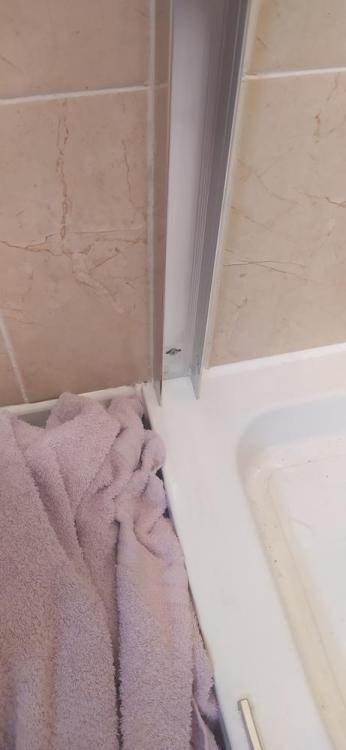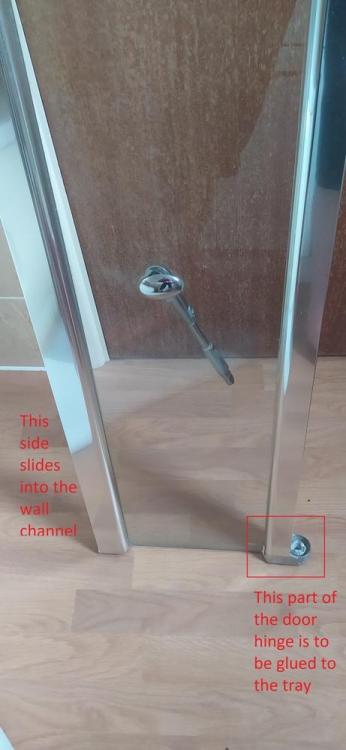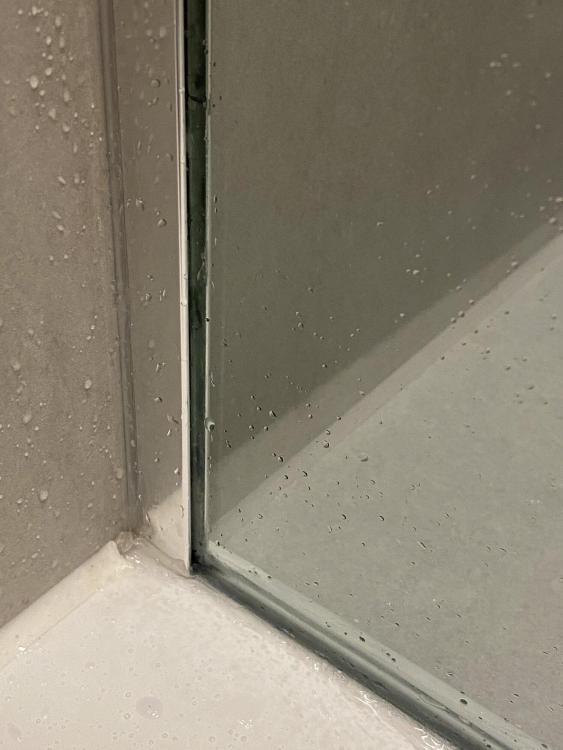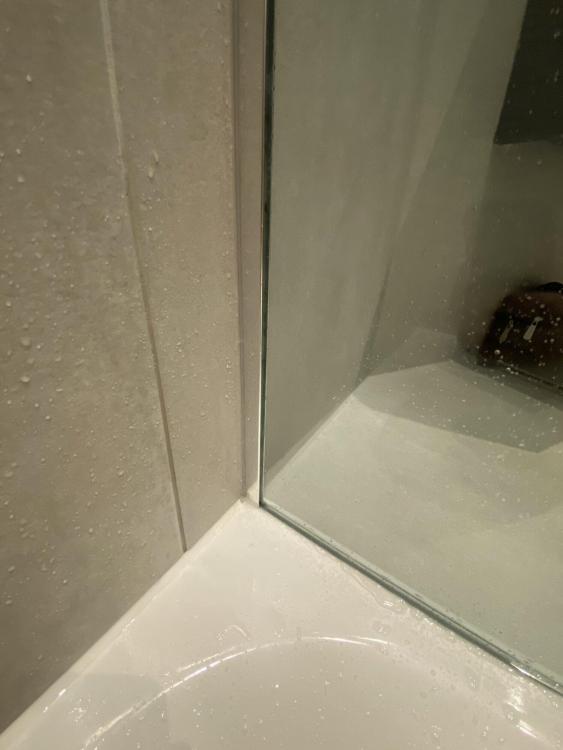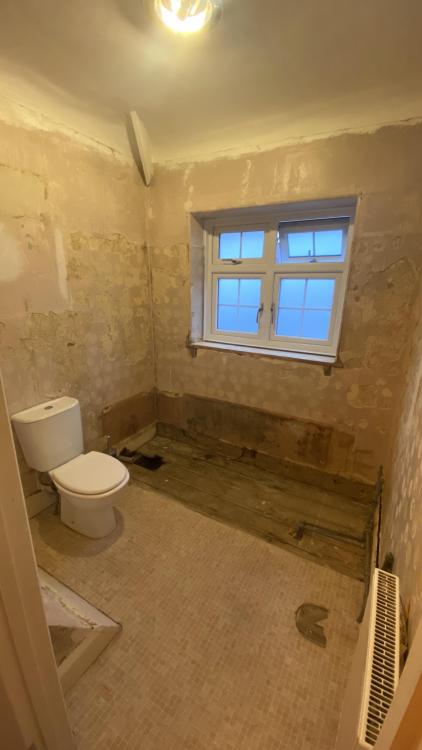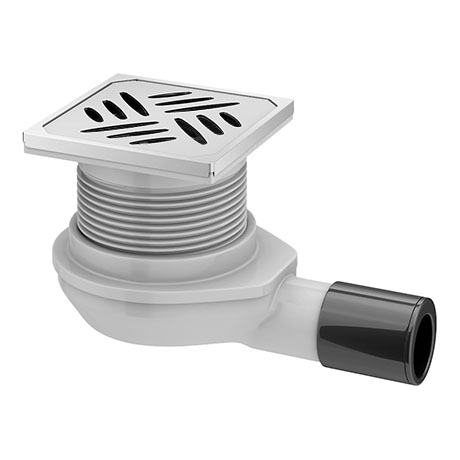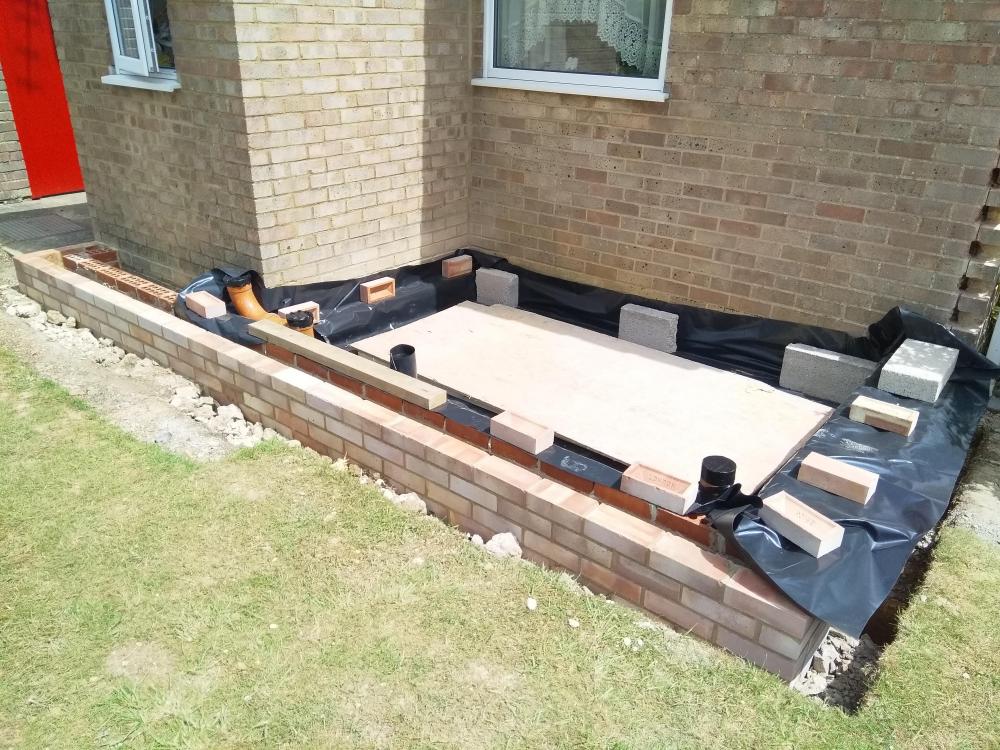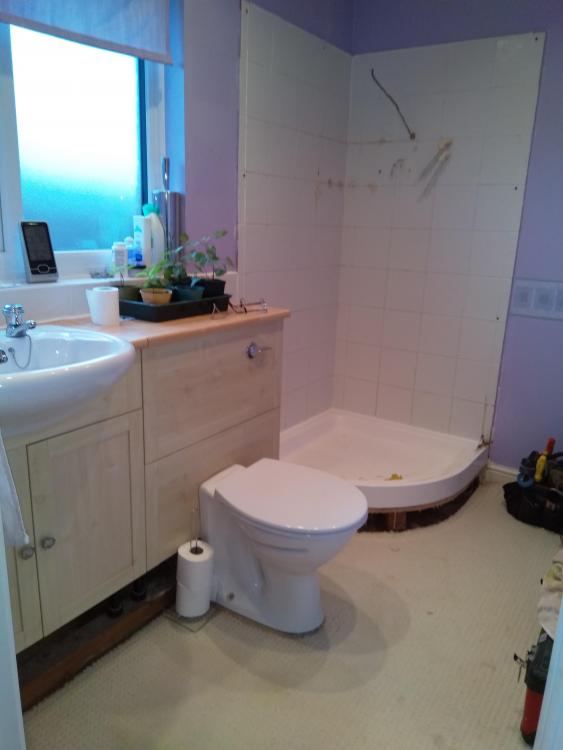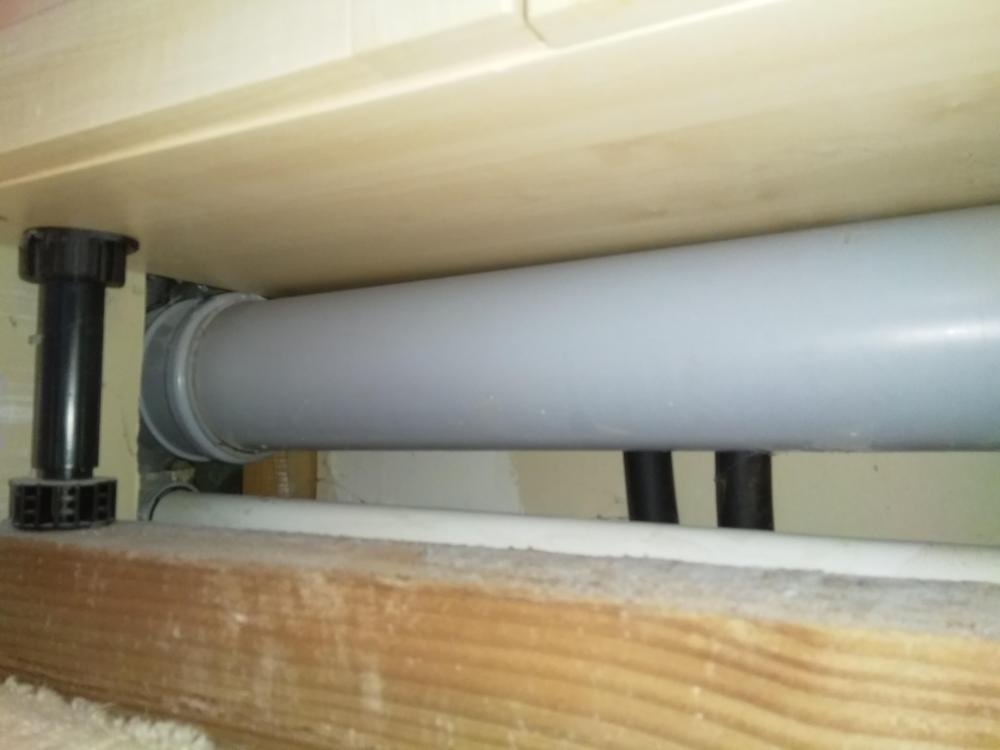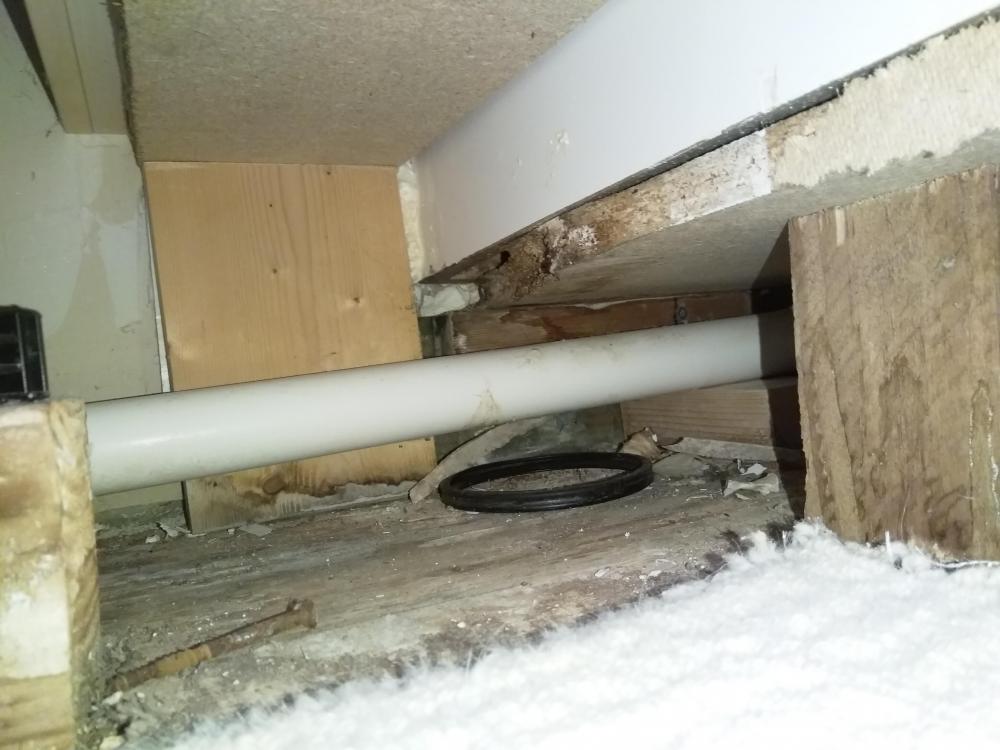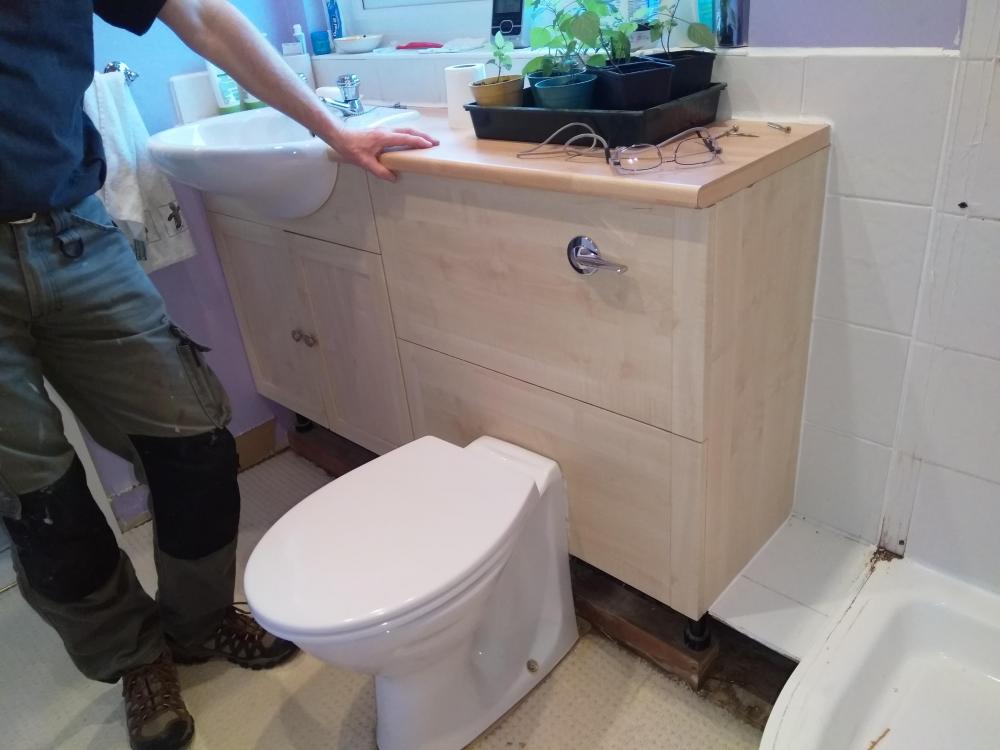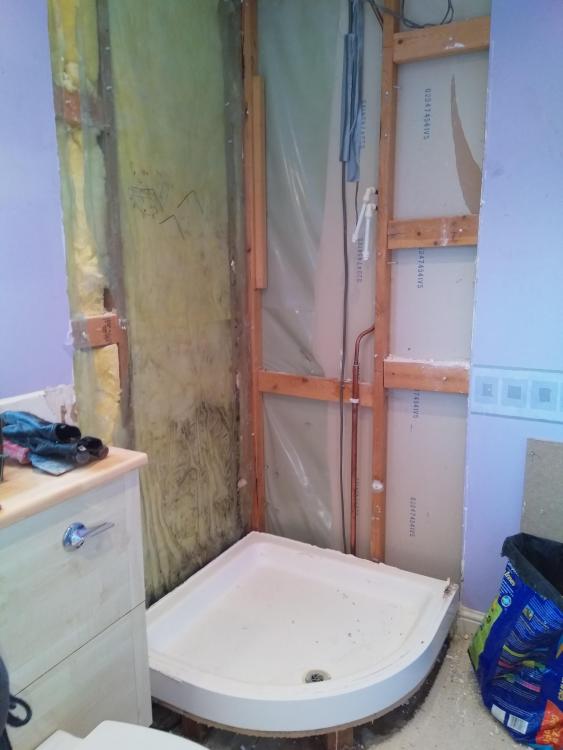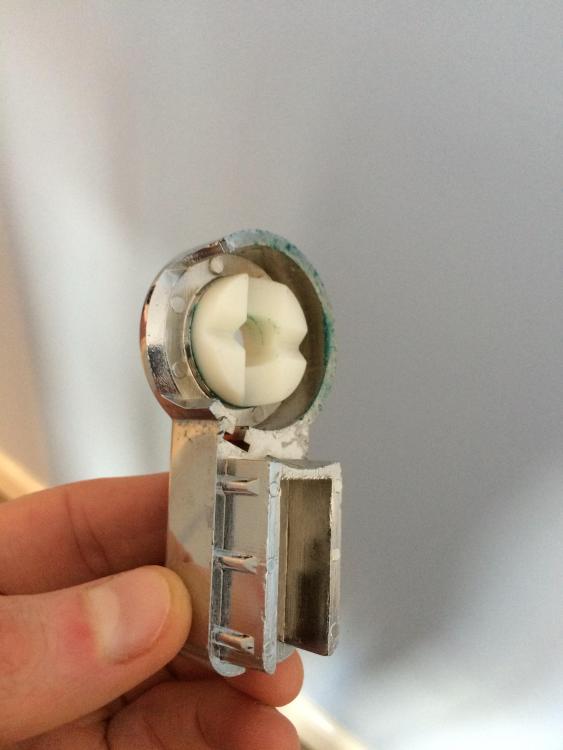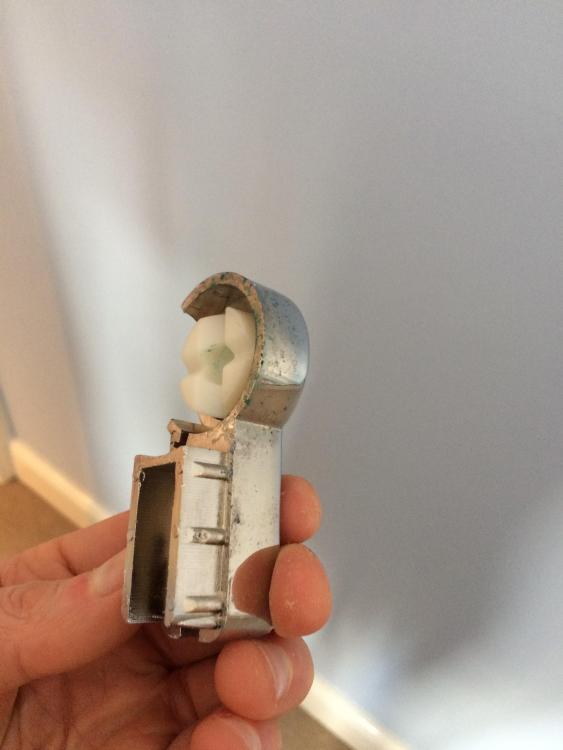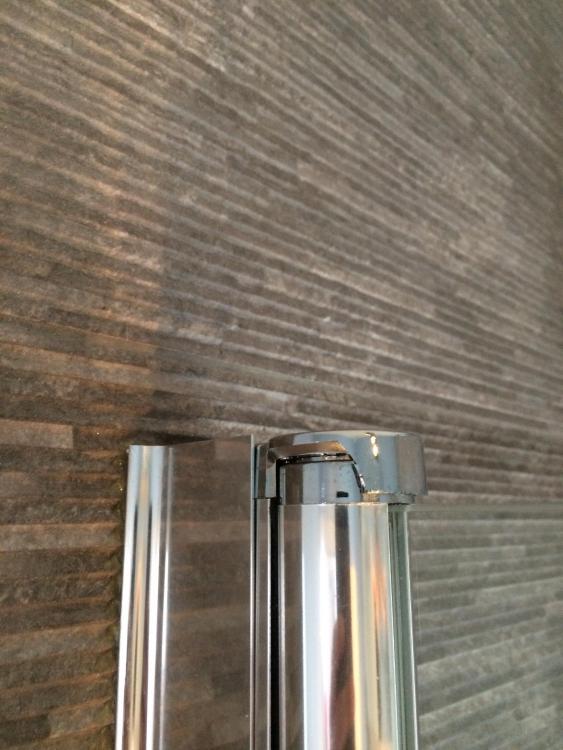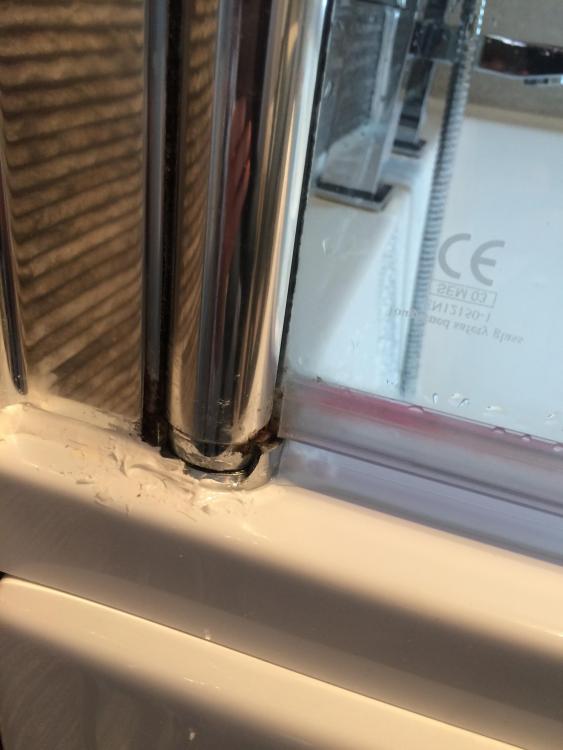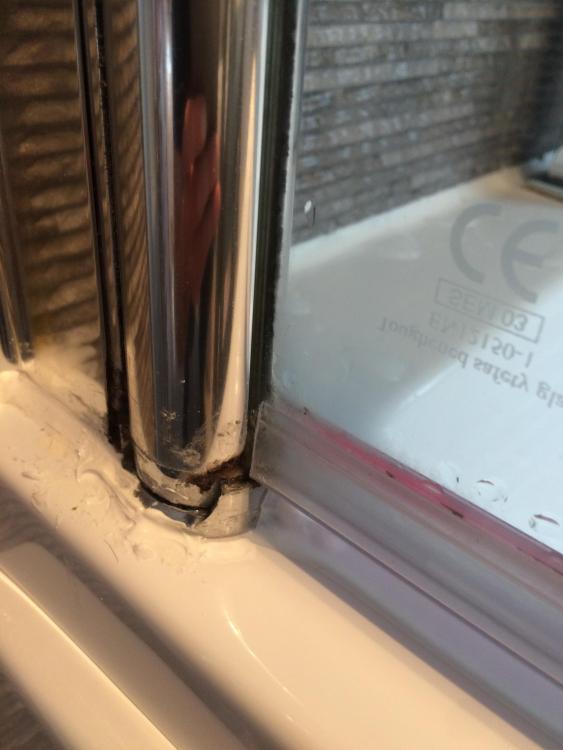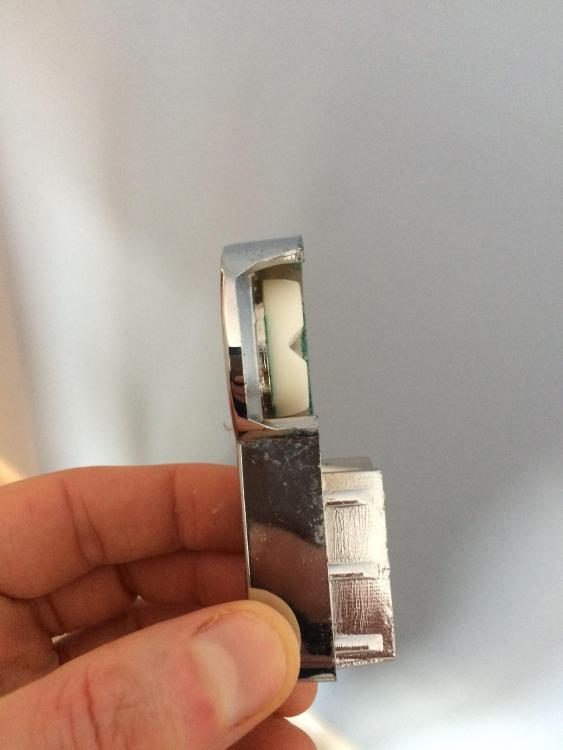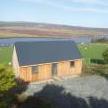Search the Community
Showing results for tags 'shower'.
-
Hi I had to remove the glass panels from this quadrant shower cubicle and I'm struggling to get one of the screens back in place properly. The small glass panel is supposed to slide into the wall channel, and some holes in the side of the channel (inside the cubicle) should align with some holes in the frame attached to the glass panel, allowing for some screws to go in and securing the frame in place. My problem is that the frame isn't going deep enough into the channel. Normally I'd take the rubber mallet to it, but I'd probably end up with glass everywhere..... I could try opening up the channel with some quick release grips, but that might cause stability problems, and open up the possibility of future leakage. Alternatively, I could try lubricating the frame a bit with some silicone lubricant - whilst this is unlikely to interfere with the silicone sealant that i'll be applyiing on the inside of the channel where it meets the tray (like how it was when I removed the glass panel), I'm not sure that this is the best approach. Can anyone suggest a better method? Also, the frame on the other side of the glass panel (which has the pivot hinge) was glued to the tray, but as I don't have the original installation instructions, I don't know what adhesive is best to use. What would people recommend? Liquid nails? Thanks
-
We've had plumbers in to install first fix pipework in our self-build followed by what they called a "mid fix" of plastic to copper pipework to come out of the walls ready for us to close up. In the main bathroom we are having a bath with taps and shower over with separate thermostatic controls (i.e. not a bath shower mixer). The pipework for the bath has the main hot and cold feed pipes going to copper and then a separate C shape of copper pipework going back into the wall and then out again where the shower controls will be. We're wondering why the main feeds couldn't have just had a T off to the bath taps and then continue on up to the shower? Can we adapt it to this? Is an isolating valve on the pipework to the shower required? The feeds come from a manifold with separate isolating valves in the utility room, the cold comes from a balanced feed (if that's the right terminology) and the hot from the hot water cylinder which is ASHP heated. Photos to help illustrate!
-

For older people: Showers, Grab Rails etc
Ferdinand posted a topic in Bathrooms, Ensuites & Wetrooms
I have been talking about refurbishing my upstairs bathroom. I also need to do the downstairs for when my elderly mum needs it. I have a couple of some specific questions, and I do not think we have a thread. She also likes sitting in the shower for a rest or a sit-down shower. Currently we have a plastic garden chair for that in a wetroom alcove upstairs. The biggest shower tray I can get in will be 1400 x 800mm (the 800mm is a bit tight, but more would be a pain), as it is under the stairs where there is currently a bath. There will be a fixed screen as many others do , plus a hinged end panel. I'll post a design etc on a blog-post. I need a walk-in shower which is as-good-as-possible rather than "acceptable", without sinking the bank. Questions: 1 - Does a non-slip shower tray offer major benefits? Is there a downside in attraction of muck or cleaning etc? 2 - In looking for a shower screen, are they available with pre-attached grab rails? In practice a pre-attached towel rail may do it, which is what we currently have. But does gonig for one with a rail on make it niche and pricey? How pricey? 3 - Are there glue-on varieties of grab rail, and other help-equipment? Are there versions available which do not look like a clinic? (Shower screens are inexpensive, so it may be the best option to replace the whole thing when the grab rail is no longer needed). 4 - Can anyone point me to a type of fold down shower chair which is more comfortable that the normal institutional-looking ones? 5 - Potentially I *may* be able to fit in a 900mm shower tray, though it would involve moving a towel rad by about 80mm. Since we are now retiling the whole thing, that be worth it. Question for any wise-owl members: is there a major benefit for less mobile people in a 900mm wide shower over an 800mm wide? I have a gut feel it could give a lot more benefit that the small change implies. Cheers Ferdinand- 10 replies
-
- shower
- shower tray
-
(and 2 more)
Tagged with:
-
I’m looking at the current regs and the activity spaces required for different elements, in particular showers. It’s shown that the 800x800 activity space starts at the edge of the shower tray. What happens if you want to have a wet room/walk in type of shower that has no tray edge as such? Where would you class the activity space starting from? https://www.gov.scot/publications/building-standards-technical-handbook-2020-domestic/3-environment/3-12-sanitary-facilities/
- 9 replies
-
- scottish building regs
- bathroom
-
(and 2 more)
Tagged with:
-
Hi, I'm new to the site. I'm not a pro just a keen DIY'er. Been reading some great posts about bathroom installations on here. I'm currently building my first wetroom bathroom in my house, a complete remodelling project. Walls moved, joists strengthened, services re-routed, new bulkhead the lot.. Wetroom constructed using abacus elements inline showertray 1800x900 and waterproof (tileable) element boards and sealed with waterproof tape. All good so far. I'm going to be tiling wetroom tray and floor flush in porcelain tile. 800x400 tiles with envelope cuts to accomodate fall in the tray. Things that's bugging me a bit is the installation of the 10mm shower glass screen - Glass will be mounted from the corner of the wall using an aluminium F bracket so that glass sits out onto the tray surface. (You'll see in the photo by what I mean - as the shower tray sits within in a recess). Wall bracket has to be installed prior to tiling. Rubber seal set into the the bracket and glass to be inserted. Which I'm told will be very tight and tough to remove once in place. Which leads me to this next part. I also have an aluminium channel that's meant to be installed at time of tiling which is to be set into the floor and tiled to either side. Now I can see several issues with this. One of them being a massive ball ache getting that installed esp. with the wall bracket that holds the glass securely and then the faf with the tiles. I seen a post by someone on here in 2017 with a reply from 'NickfromWales' surface mounting glass directly onto the tile with CT1. I'm tempted to launch the floor channel and go down that route. Nick, How's the CT1 holding up - glass still secure? Other option that I am considering is to install glass first directly onto wetroom tray using CT1 then tile up to the glass and seal. But then I'll have a potential issue at the base of the glass that could leak in the future with that method due to the split in the tiled floor. I've also got a top mounted support bar to hold glass in place. Any help would be greatly appreciated. Cheers Kev
-
Quick and easy Q. for the gurus- does anyone know of a flipper panel that is less than 300mm? Ideally 150 or 200. Not picky on thickness as I haven't ordered the main panel yet. I want to chicane a walk-in entrance to the "corner" of a 1400x900 tray and 300+ 600 feels a bit tight...
-
So I have a question here and I’m completely lost, I had a shower screen replaced as it shattered. The fitter came and fit the new wall profile to the wall in the place of the old profile using the same holes, then fitted the glass and then sealed it with silicone. When I first used it it started leaking from the bottom corner as shown in the pictures. He came back and took off the glass and Re fitted glass with new silicone and I allowed it 4 days to set. The same issue has happened again where is it leaking on the outside in the corner by the profile(bottom right in the first image is where the leak is). It looks like the water is entering the profile half way up on the inside then dripping down and coming out the wrong side on the outside of the shower screen in the corner. Any thoughts on why this happens from the images? Much appreciated and help
-
Good Evening and Happy New Year My next question for estimation. Once I have listed everything that I think that we need and got my approximate estimate I shall send off, but right now I'm listing everything and pricing it myself, this is what covid does to you when you can't go to the pub. My single storey barn conversion has a flat roof so there will not be any form of header tank, there will be an emersion tank in the utility room. We will have 3 showers for which I need pumps. But, all the ones I look at say 'gravity fed', which sounds to me like they need a higher tank. These pipes will need to be horizontal, one at 2m, one at 12m and one at 25m, all from the DHW tank. It is very rare that multiple showers are used at the same time, but not impossible. I'm not worried about the hot water, we have 2 showers with pumps in the existing house and it has not been an issue waiting for hot water. My issue is that I don't know what type of pump I need. I know one of ours needed replacing recently, at about £200. The existing pumps are on the same level as the showers by the tank, but we do have a cold water header tank and I'm not sure if this makes any difference. Do I need the same as we have now. TIA Jill
-
Hi everyone, We’re going to have our bathroom refitted in the very near future and we’ve decided we’d like a spa bath and a digital shower (not pumped but digitally controlled) Bath: https://www.thewhirlpoolbathshop.com/single-ended-baths/aquaestil-plane-solo-14-jet-whirlpool-bath shower: https://www.plumbworld.co.uk/mira-platinum-digital-shower-dual-concealed-101375-27988 I’ll have an electrician out to install the power but I wondered if anyone had any experience with this type of electrical install? The sort of cost to expect would be great too, we’re in south east London so a rough figure would be good as I’d rather not be overcharged! I’m assuming that the electric will be taken from the plug socket in the bedroom next door, drilled through into the bathroom and then run through an RCD and isolator? Is it possible to have an isolator in the bathroom on a pull cord above the door? (Please remember I’ve no experience of this and am not doing it myself, the bathroom is going to need to be replastered too and I want to make sure I have some knowledge for when an electrician visits for hiding of cables etc). Can the digital shower unit be installed under the bath? The Mira documentation says it can but it doesn’t seem right to me? Will there need to be more than one isolator with the electrics with different power going to two different pieces of electronics? It’s only a small bathroom and we’re going to have a small stud wall fitted to conceal the pipes for the wall mounted shower. Thanks in advance, any insight you can give me would be very much appreciated. Robbie.
-
We are installing a shower, toilet and basin into a new extension for the parents and we have a question about the feed for the basin. basically the current system consists of a large hot water tank in a cupboard in the hall, a loft cold water tank with only abouut 500mm between the two. its a bungalow. there is a rising main into the loft tank from which we are taking a cold water feed to the shower. There is a cold feed from the loft tank that we can use for the cold feed to basin and toilet but we have an issue with the hot feed. The hot feeds leave the hot water tank and go straight down into the concrete floor then re-appears in the kitchen and bathroom for the sinks and bath. The hot water vent comes off shortly after leaving the tank as usual. as we need to take a new hot water feed up into the loft and across into the new extension ceiling, we are worried about the lack of pressure to the basin. are there any systems available to help pump the hot water to the extension (its about 5 metres) or do you think the pressure will be okay. The parents are used to the current system and its okay, not brilliant. I'll try to add a diagram but my scanner is playing up!
-
We are busy with Mum and Dad's new wetroom extension and the builders are getting the roof on so we planning the internal fit out. The floor is concrete, insulation then a screed which the builder assures me will have the correct falls for me to tile. No need for a former or shower tray. and he is quite a perfectionist so I am sure it will be fine. (He took down the rafters and re-fit them as one side was 1cm out from the other!) anyway - we are looking to fit a square drain such as this one - the OH, who will be fittng it, was asking about the need for a U-bend? There isnt going to be room for one. Is that okay? the concrete has been laid for the floor with a largish brown pipe in place for the waste and Fred, who did the foundations, said the drain fits into the insulation layer and the screed is laid around it. does that all sound correct? Here is the build a couple of weeks ago. the corner pipe nearest the camera is the shower drain location.
-
Elsewhere I have talked about my project this year to upgrade my two bathrooms. One aim is to have 2 showers that can be run simultaneously. I have a big Combi that is well able to do it heat wise. My current flow measurement at the cold kitchen tap on full is about 9-10l per minute. I may have scope to up the pressure slightly. I am happy to embrace eg shower heads which use less water. There will be one electric and one mixer showers. The plumber has initially recommended a boost pump, rather than the accumulator I was think about. Can anyone comment on pros and cons, and any measurements I need to make to help making the best decision. Thanks Ferdinand
- 10 replies
-
Present house has a themostatic bar mixer valve. when it works, it is great. BUT... The present house is 12 years old. At 4 years old, the mixer stopped regulating properly, so i replaced the thermostatic cartridge. At 8 years old, it failed again. Although the original cartridge came out easily, I had to press VERY hard (vice) to get the new one fully home, so I thought the chance of getting it out to replace it again was slim. So I bought a whole new bar mixer. Now at 12 years old, it's failed again. So is 4 years the "normal" life? is it considered normal to have to repair or replace them every 4 years? If so I will be lookinf for something different for the new house, something that just keeps working. SWMBO of course blames me for buying the cheapest. That is true of the current one, but not the original. Is it really true that if I spend more, it might last longer than 4 years? Is it a problem with our water? We have very soft water here so I can't think of an issue, but clearly something is gumming up inside. Is it worth digging out the original one, giving it a few days soaking in something like Viakal and trying it again? Ideas and observations please.
-
We have decided its time to update our en-suite and change the quadrant shower for one across the whole of the back wall. when we did the quadrant, you can see that we stood the shower tray on thick ply, sitting on wooden blocks. this was to give sufficient room for the drain, which runs left under the vanity units and into the large pipe which runs down the corner of the bedroom, the other side of the left hand wall. We would like to have the new shower tray on or nearer the floor so there isnt a step. The floor joists run at 90 degrees to to direction the waste would need to go meaning drilling each one with min 32mm hole for the waste, until it gets to the main soil downpipe, having dropped it accordingly. This will also mean having half the floor up. As far as regs go the joists are deep enough (min 0.25 of joist depth) but we would need to come out to 0.25 to 0.4 of the span too which would be awkward Are there any techniques or methods these days which might be easier? this shows the shower drainpipe running into the soil pipe. the large grey one is the soil pipe from the loo. The white drain pipe running from under the shower tray. The plasterboard and tiles removed. they were ordinary plasterboards but we shall do it with proper aquaboards this time. (any recommendations for those too would be appreciated)? You may notice that the vanilty units also sit on 10cm blocks of wood - we like to have a higher than usual sink; is much nicer than the usual height. So - any good ideas that we can try?? thanks, in anticipation.?
-
Hi, if anyone can help that would be great. My shower has always had a small small leak but never bothered me as was the odd drip every now and the. Recently it’s began gushing water. It was fitted 2 years back and one of the parts seemed odd then, and now it’s were the water is coming from. I’m wondering if they’ve fitted it the wrong way round, as it seems the gap would be to release water back into the shower and not out of it. I’ve added photos if any plumbers can have a look and let me know that’d be great. I’ve taken the top one off to take a photo, the gap faces outside the shower on both top and bottom. Also, the caulk is what I’ve done when trying to stop the leak, yes it’s crap haha. thanks phil
-
Due to a "design issue" (AKA Cock Up!) I've ended up with a MHRV extract plenum in the shower area. From what I've read this is against best advise. Assume this is due to the levels of humidity in the ducting?? Is it an absolute "no" or in reality is it not too much of an issue. Moving it is not an option now but I could change the bathroom design but it would be a considerable compromise. TIA
-
This week the OH and I removed a bath and refitted a shower room for my (aging) parents. They didnt want to spend a huge amount and we ended up getting it all from B&Q - the Cooke and Lewis Exuberance Rectangular shower encosure with single sliding door and the Cooke and Lewis Lagan shower tray. The quality was quite good for the price, IMO, and we followed the instructions (pictures only) to the letter. We also followed @Nickfromwales's advice and used Sikaflex EBT to create an upstand when we positioned the tray against the wall. However, when we used the shower to test it out, there was a load of water coming from the base of the enclosure on the side wall nearest the shower, where it joins the wall. When constructed, the glass panels were slid into a metal (aluminium maybe) trim which in turn, slid into the section which we had glued and screwed to the wall. the base of the glass panels fixed into another trim but these also had a plastic thingy (technical term for the non-plumbers) which we think seals the glass into the trim so no water can get in. But not at the side panel. As the shower tray has a completely flat bit for the enclosure to sit on, we were a bit concerned about water seeping under the enclosure as we hadnt been told to stick it down with sealant. So I used some Sikaflex and applied a thin bead all around the base, sealing the bottom of the enclosure to the tray, on the inside. The water seems to be getting through the part where the glass panel fits into the first metal trim. It does seems strange that it did not need sealant or a plastic/rubber seal. But I wonder if I actually created the problem here. Maybe the design is for the water to get into that area but then drain out the bottom - although what would stop it draining out the outside, I dont know. In the end some clear CT1 in a bead all the way up that join seems to have slowed the water escaping but not completely. At least it was just seeping slowly out rather than pouring out. And that was with the shower head pointing straight at it, which isnt going to happen under normal use. Was it me or the design? The bit where we think the water is getting through is that black line where the glass was slid into the metal trim, which then slid into the wall trim, already fixed to the wall.You can see the thin bead of sikaflex that I applied all round the base.
-
Planning my first fix plumbing and wiring and so it's decision time for my DHW. As a small building used for holiday lets I will not have a boiler or the need for any bulk hot water storage. I also don't want to be paying for standing losses on a house that might go empty for weeks at a time. So the options are: a) Electric shower + two individual under-sink IHW units, one in the kitchen and one in the bathroom b) Electric shower + multipoint IHW unit feeding both the basin and sink. I could site this near the CU which would be about mid way between the two outlets. c) Multipoint IHW feeding the shower, basin, and sink. The last option is very tempting as it would in some ways be the simplest, and possibly the cheapest. Also prevents the possibility of overloading the power supply. But you would want the IHW to produce higher temps, for dish washing, than you'd need for a shower- and I am right in thinking that it's quite inefficient to have to dilute hotter water back down again? If it was my own house I would live with the shower temp water, and top it up with a kettle if I needed to soak some dishes... but it's not my house, and everything needs to be idiot proof I know that @JSHarris has had success with his IWH, albeit in a quite different application.
- 84 replies
-
- shower
- water heater
-
(and 3 more)
Tagged with:

